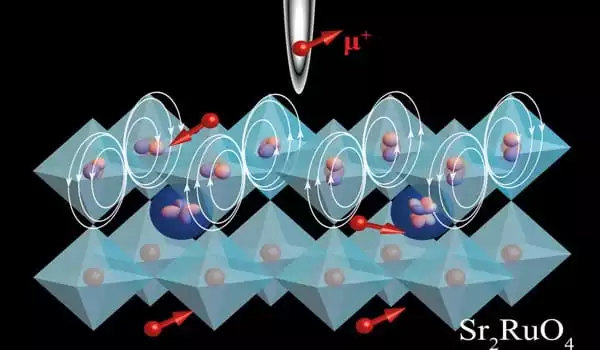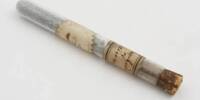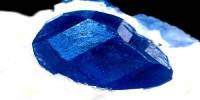Scientists have made a ground-breaking discovery in strontium ruthenate, which has the potential to open up new avenues for quantum electronics applications. Since the discovery of superconductivity in Sr2RuO4 in 1994, hundreds of studies on this compound have been published, implying that Sr2RuO4 is a very special system with unique properties. Because of its ability to carry lossless electrical currents and magnetic information at the same time, Sr2RuO4 is a material with great potential for the development of future technologies such as superconducting spintronics and quantum electronics.
An international research team led by scientists at the University of Konstanz has now answered one of the most intriguing open questions about Sr2RuO4: why does the superconducting state of this material exhibit some properties that are typically found in ferromagnets, which are considered antagonists to superconductors? The researchers discovered that Sr2RuO4 contains a new type of magnetism that can coexist with superconductivity while also existing independently of superconductivity. The findings were published in the most recent issue of Nature Communications.
The missing piece of the puzzle appears to have been discovered after a multi-year research study involving 26 researchers from nine different universities and research institutions. The study included the universities of Salerno, Cambridge, Seoul, Kyoto, and Bar Ilan, as well as the Japan Atomic Energy Agency, the Paul Scherrer Institute, and the Centro Nazionale Delle Ricerche.
Scientists have made a path-breaking discovery in strontium ruthenate, with potential for new applications in quantum electronics.
So far not the right tool to find evidence
“Despite decades of research on Sr2RuO4, no evidence for the existence of this unusual type of magnetism in this material had been found. However, a few years ago, we wondered if the reconstruction that occurs on the surface of this material, where the crystal structure exhibits some minor changes at the atomic scale level, could also lead to an electronic ordering with magnetic properties. Following this intuition, we realized that this question had probably not been addressed because no one had used the “right tool” to find evidence for this magnetism, which we thought could be extremely weak and limited to a few atomic layers from the material’s surface,” says the study’s leader, Professor Angelo Di Bernardo of the University of Konstanz, whose research focuses on superconducting spintronic and quantum devices.
The experiment was carried out using high-quality single crystals of Sr2RuO4 prepared by Dr. Antonio Vecchione’s group at the Centro Nazionale Delle Ricerche (CNR) Spin in Salerno. “Making large crystals of Sr2RuO4 without any impurities was a big challenge, but it was critical for the experiment’s success because defects would have given us a signal similar to the magnetic signal we were looking for,” says Dr. Vecchione.

The right tool is a beam of muons
The special “tool” used by the researchers to reveal the new magnetism is a beam of muon particles produced in a particle accelerator at the Paul Scherrer Institute in Switzerland (PSI). “PSI is the only facility in the world capable of producing muons with a precision of a few nanometers. These particles, which can detect extremely small magnetic fields, could be stopped very close to the surface of Sr2RuO4, which was critical to the experiment’s success “Dr. Zaher Salman, who coordinated the experiment at the PSI muon facility, explains.
“It’s been a really nice experience since the beginning of my doctorate in Konstanz to carry out measurements in an international beamtime facility like PSI and interact with such a large group of inspiring scientists from all over the world,” says Roman Hartmann, a doctoral researcher who also contributed as the first author to the study.
The authors also created a theoretical model that explains the origin of this hidden surface magnetism. “Unlike conventional magnetic materials, which derive their magnetic properties from the quantum mechanical property of an electron known as spin, the magnetism discovered in Sr2RuO4 is based on a cooperative swirling motion of interacting electrons, generating circulating currents at the nanometer scale,” says Dr. Mario Cuoco of CNR-spin, who developed the theoretical model with Dr. Maria Teresa Mercaldo and other colleagues at the University of Salerno.
New insights for basic and applied research
According to University of Cambridge Professor Jason Robison, the findings confirm that “physical properties can be dramatically modified at a complex material surface and at interfaces within thin-film heterostructures, and these modifications can be exploited for discovering new science for basic and applied research, including the design and development of quantum devices.”
Professor Yoshiteru Maeno of the University of Kyoto is also a co-author of the project. He is the scientist who discovered superconductivity in Sr2RuO4 in 1994 and has contributed to some of the most important studies on this material published in the last 30 years.
“This finding not only solves a long-standing puzzle and makes the iconic material Sr2RuO4 even more interesting than before, but it may also trigger new investigations that eventually help to answer other striking open questions in materials science,” says Professor Elke Scheer of the University of Konstanz, another project leader and head of the Mesoscopic Systems research team.
The new type of magnetism discovered in Sr2RuO4 is critical for better understanding the material’s other physical properties, including its unusual superconductivity. The fundamental discovery may also prompt the search for this new type of magnetism in other materials similar to Sr2RuO4, as well as new research to better understand how such magnetism can be manipulated and controlled for novel quantum electronics applications.















